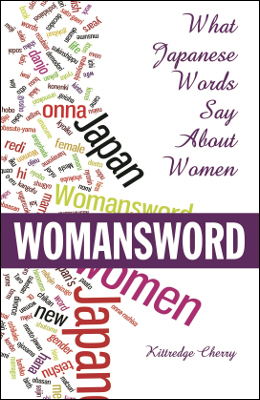|
by Aaron Chan

Kittredge Cherry, Womansword: What Japanese Words Say About Women (30th Anniversary Edition), Stone Bridge Press, 2017. 182 pgs. Consisting of eighty-one words and phrases related to Japanese women categorised into seven sections, Kittredge Cherry's Womansword: What Japanese Words Say About Women is an interesting and leisurely read, and at the same time, a special dictionary with rich cultural insights. This detailed investigation of Japan's heavily gendered language opens the door to a history of gender in Japan that continues to be felt today but which is also undergoing transformation. The Japanese language is gendered not in the grammatical sense as in French and German, but in its ideography and etymology. A recurring pattern in the entries in Womansworld is that in Japanese kanji (漢字) characters, the ideogram of onna (女)—meaning "female"—is often combined with another ideogram to form a character, which usually denotes a characteristic pertaining to a particular type of Japanese female. For instance, musume (娘), the character for "daughter," is composed of the ideograms for "female" and "good" and yome (嫁), the character for "bride," is composed of the ideograms for "female" and "home." However, there are very few examples where the ideogram of otoko (男)—meaning "male"—is included as part of a complex character in the same way, a fact which speaks to the particularly gendered nature of Japanese. Cherry also points out the same pattern on the word level, particularly with regard to words about jobs, many of which are traditionally regarded as only suitable for men. For example, an authoress would be called a joryu sakka (女流作家, "female stream author") and a policewoman would be called fujin keisatsukan (婦人警察官, "lady police officer"), while their male counterparts would simply be called sakka and keisatsukan without a pre-modifier. For some other entries, the words or phrases indicate some culturally specific events and concepts that are either absent from or understood differently in Western cultures. Some refer to certain specifically Japanese festivals, including hina matsuri (雛祭り, "Doll Festival") and seijin no hi (成人の日, "Coming-of-Age Day"). Some reflect various husband-wife relationships in Japan, such as nomi no fufu (蚤の夫婦, "flea couples"), which refers to a couple with a taller wife and a shorter husband or sodai gomi (粗大ゴミ, "giant garbage"), which is used by housewives to refer to retired husbands who just sit at home and get in the way like a huge piece of garbage. A comparison between the metaphors used in Japanese and English to refer to married couples—oshidori fufu (おしどり夫婦 or 鴛鴦夫婦, "mandarin-duck couples") in Japanese versus "lovebirds" in English—reflects a difference in the cultural view of relationship. And eikyu shushoku (永久就職, "eternal employment") as a term for a woman's marriage might also be of interest to fans of the 2016 topical Japanese drama Nigeru wa Haji da ga Yaku ni Tatsu (逃げるは恥だが役に立つ), one of whose central themes is the value of housewives in Japanese families. Another noteworthy category of words appearing in some of the entries are gairaigo (外来語)—words borrowed from foreign languages, mainly English, written in a different set of Japanese characters called katakana. These words are often imported to denote actions that were previously inconceivable and hence lacking corresponding traditional Japanese terms. For instance, the action of dating as a free act between male and female was non-existent in traditional Japanese society in which marriage was arranged, and hence the word deeto (デート, "date") was imported from English. In some other occasions, gairaigo are used as more neutral replacements for words and phrases with derogatory connotations in traditional Japanese. For example, the foreign word shinguruzu (シングルズ, "singles") is used as a gender-neutral term instead of urenokori (売れ残り, "unsold goods"), an objectifying expression referring to an unmarried women. There are also instances where foreign words are appropriated and mutated in the creation of new expressions. For instance, mamagon (ママゴン, "mama-saurus")—a mother that is scary like a dinosaur—is a compound word made up of mama ("mother") and the suffix -gon, which is believed to be taken from the English word "dragon." One alluring feature of Womansworld is the rich cultural and historical references that the Cherry makes. For each entry, the book not only provides the literal translation and the meaning of the word, but also an explanation of its cultural roots and significance. The author also assembles a number of related Japanese expressions for each entry. It is therefore actually a serious underestimation to say the book only consists of eighty-one words and phrases. According to the index, there are more than five hundred expressions introduced throughout the whole book. Instead of merely a dictionary entry, each word or phrase provides an introduction to an aspect of gendered Japan, from girlhood to motherhood, from traditional myths to contemporary relationships. As suggested in the double meaning of the book's title, which is also explicitly explained in the preface, this book is about a "woman's word," and at the same time also a "woman sword" that "can cut incisively to the heart of cultural assumptions." As somebody whose first language is Chinese and who also has some mastery of Japanese, in subsequent editions I would suggest supplying the kanji characters of the expressions that are introduced as related terms as well, as this would more effectively illustrate the ideographic features of the characters and be of assistance to readers who have some understanding of kanji or Chinese characters (although I personally enjoyed the process of deciphering the expressions written in romaji).* But all in all, Womansword is indeed a joyful read and a fascinating introduction to gender tensions in Japanese culture through insightful sociolinguistic analysis. *Publisher's update: 'The copy the reviewer received was a review copy/unfinished version. That version did not contain the index, but the final does.'
|